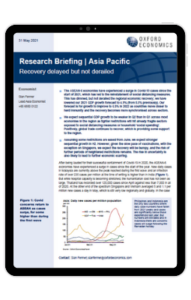APAC | Recovery delayed but not derailed

After being lauded for their successful containment of Covid-19 in 2020, the ASEAN-6 economies have experienced a surge in cases since the start of the year. New daily cases in Malaysia are currently above the peak reached during the first wave and an infection rate of over 235 cases per million at the time of writing is higher than in India (Figure 1). But while hospital capacity is becoming stretched, the humanitarian cost has not been as large. Thailand has recorded over 120,000 cases since April against less than 7,000 in all of 2020. At the other end of the spectrum Singapore and Vietnam averaged 5 and 1.1 per million new cases a day in May, which is still very low regionally and globally.
What you will learn from this report:
- The ASEAN-6 economies have experienced a surge in Covid-19 cases since the start of 2021, which has led to the reinstatement of social distancing measures. This has dimmed, but not derailed the regional economic recovery; we have lowered our 2021 GDP growth forecast to 4.9% (from 5.5% previously). Our forecast is for growth to improve to 6.5% in 2022 as countries move closer to herd immunity and the recovery becomes more synchronised across sectors.
- We expect sequential GDP growth to be weaker in Q2 than in Q1 across most economies in the region as tighter restrictions will hit already fragile sectors exposed to social distancing measures or household ‘social spending’. Positively, global trade continues to recover, which is providing some support to the region.
- Assuming some restrictions are eased from June, we expect stronger sequential growth in H2. However, given the slow pace of vaccinations, with the exception on Singapore, we expect the recovery will be bumpy, and the risk of further periods of heightened restrictions remains. The rise in uncertainty is also likely to lead to further economic scarring.
Tags:
Related Services

Post
House prices continue to slide for China’s cities
Research Briefing APAC | Recovery delayed but not derailed While the property market downturn has been universal, the scale and depth has been varied for different cities and regions.
Find Out More
Post
The Construction Productivity Challenge in Australia
Delve into the state of construction productivity in Australia. Understand the factors affecting growth and how innovation can transform the industry for the better.
Find Out More